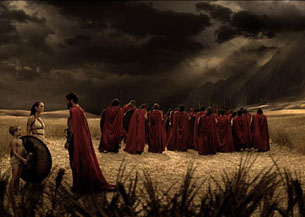Top 12 Film Industry Stories of 2007: #8:
Spartans Unleash Box Office Fury
December 29, 2007
BoxOfficeProphets.com

Butler's career had played out in similar fashion. His titular work in The Phantom of the Opera had failed to earn back the production's $60 million budget, winding up with a mediocre $51.2 million. His largest role in a big budget epic previous to that was in Timeline, a disastrous project that failed to earn back even a quarter of its $80 million budget. Until 2007, the only true success story in Butler's box office career was in the title role of Dracula 2000, a $28 million production that squeezed out $33.0 million before exiting theaters and the collective consciousness.
Nothing by way of star power was going to sell 300.
The scary thought about the project was that a director with exactly one movie on his resume, Dawn of the Dead, already had a bigger hit than either of the film's stars. Zack Snyder was already being described as an ascending talent after he delivered a white-hot action title that earned back over twice its budget with $58.9 million worth of box office. Snyder had already captivated audiences more after one attempt than Headey and Butler had managed in over 70 combined projects. As strong a debut as Snyder had, it wasn't until he decided to adapt a Frank Miller comic book into a feature length film that he became one of the hottest directors in Hollywood.
Frank Miller had been writing comic books for three decades, earning a reputation as one of the brightest, most imaginative creators in the industry's history. It was only when Robert Rodriguez bravely embarked upon an adaptation of Sin City that Hollywood began to take note of his work. When the fresh-looking action noir title earned $29.1 million in its opening weekend, the entirety of Miller's catalogue became a popular read for studio execs' assistants. Sin City eventually wound up with domestic receipts of $74.1 million against a $40 million production budget, making it one of the strongest performers relative to budget of the year. That total would prove to only scratch the surface of what a Miller adaptation could do if marketed impeccably.
Despite its lack of star power and relatively unknown director, 300 had quite a bit going for it. Snyder had made a novel decision in adapting the comic book. He decided to model it in the format of a videogame, complete with occasional boss fights. This modular style of filmmaking was still divisible in the standard format of the three-act screenplay, but the much more frequent action sequences had a huge benefit in terms of marketing. Teasers and trailers were easy to make and visually stunning to witness. The comic book look had been translated into lush cinematic visuals that captivated all the viewers who came across these commercials. And anyone who has read this site over the past decade knows that the level of box office receipts always directly tracks back to the trailer.
The end result was still stunning. 300 opened to $28.1 million on its first Friday. At the time, it was the 41st largest single day of box office ever, although it has already fallen to 56th in the wake of the three-quel summer for the ages we experienced a few months later. 300 went on to earn $70.9 million in its first weekend, making it the largest opener in March history. It surpassed the previous record holder, Ice Age: The Meltdown, by a solid 4.3%. Perhaps more impressively, this number also represents the third-largest opening ever for an R-rated opener. Only the much more heavily hyped The Matrix Reloaded ($91.8 million) and the much more controversial The Passion of the Christ ($83.8 million) have done better. A film with a $60 million budget had smashed that number in only three days. Along the way, it also exceeded the prior best performances of both lead actors as well as its director.
300 is proof of the notion we espoused when BOP first went online in 2001. A quality movie can open huge at any point on the schedule; furthermore, rating does not matter to the bottom line. If it did, studios would stop making R-rated movies. At the end of the day, what determines a film's fate is its marketability and its quality. 300 claimed both, at least as far as mainstream audiences were concerned. Critics were less kind, but who cares? They don't pay to see the movies anyway. $210 million worth of consumers spoke with their wallets, making 300 one of only eight titles to clear the $200 million milestone. It currently stands as the seventh most successful movie of the year, making it one of the most remarkable surprise performers of 2007.